MACRO OCTOBER IN MARLERA - Episode Fourteen - ON OCTOBER 25
The weather was still pretty warm on the 25th of October. It was a sunny day, the sky was clear and almost completely blue in the early afternoon when I spent a couple of hours searching for spiders and insects to feed my passion for exploring the small details of the living world around me. Just like in every segment of this relatively long series, the photographs you'll see in today's episode were all taken in Marlera, the coastal area situated a couple of kilometers from the village of Liznjan and about five or six kilometers from where I live.
Marlera is a place that offers a nice biodiversity a short drive from home. A kind of place that never disappoints me.
The grasshopper shown in this photograph and the well-camouflaged beetle shown in the following one ...
... were both photographed on the leaves of the same plant ...
... the impressively long leaves of the Onopordum illyricum thistle.
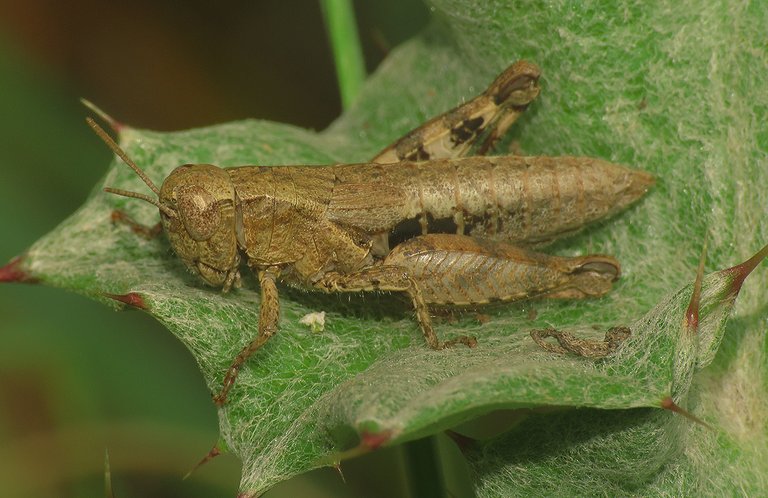
The grasshopper is Pezotettix giornae, a species that already appeared in some of the previous episodes.
The beetle is Cassida rubiginosa, commonly known as the thistle tortoise beetle, a species from the Chrysomelidae family. Next to this Cassida rubiginosa which was displaying its antennae ...
... there was another one that didn't. When the flat beetle hides its legs and antennae under the large casing made of pronotum and elytra, it looks like a green limpet on the green surface of the leaf and is therefore very hard to notice.
Here you can see both beetles, posing fairly close to each other, in the same shot. First I took quite a few photographs with the flash of my camera on, becouse it was easier that way. The shutter speed was nicely high and everything was more manageable, but ...
... but I liked how the green looked in ambient light so I took the time and effort to get at least one more photograph without involving the flash.
Both the adults and the larvae feed on various plants from the Asteraceae family, which includes thistles.
Five or six meters from the flat young Onopordum illyricum that still hasn't grown the robust stem ...
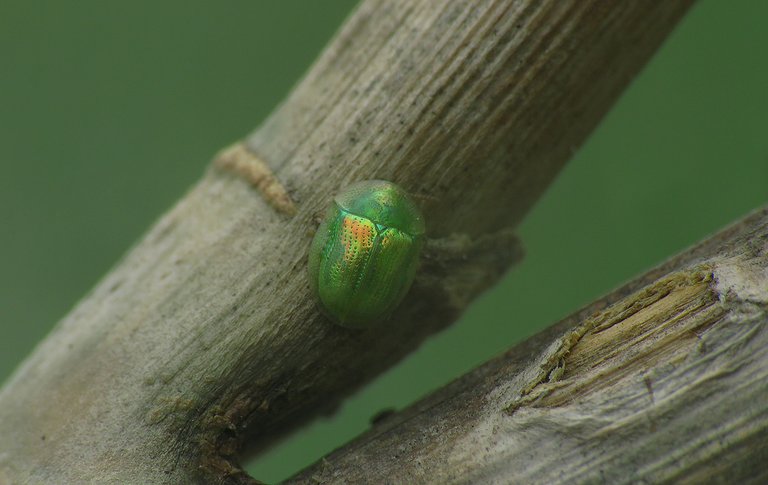
... on the pretty tall, dry remains of the Foeniculum vulgare plant, I found another species from the genus Cassida of the Chrysomelidae family.
This beautiful beetle was completely new to me. Only today, while preparing this post, I found out on the Internet that the name of the species is Cassida margaritacea.
While very similarly shaped, Cassida margaritacea is slightly less flat and much smaller than Cassida rubiginosa.
Both the adults and the larvae feed on various plants from the Caryophyllaceae family. The most numerous host plants in Marlera are probably Silene vulgaris and Silene latifolia.
This is the Echium italicum. A dry Echium italicum, to be more precise.
I photographed quite a few of these plants on the 25th of October. In the following shot ...

... you can see a grasshopper that was resting on one of them. A few seconds after the photograph was taken, the Aiolopus strepens - that's the scientific name of the species, jumped away.
This Eublemma parva ...
... a moth from the Erebidae family ...
... was photographed on another Echium italicum plant not far from there.
These moths mainly inhabit hot and arid areas. Places like nutrient-poor grasslands, rocky slopes, and scrubland. All the three mentioned habitats are present in Marlera.
The larvae feed on quite a few plants from the Asteraceae family. One of those host plants, the Dittrichia viscosa, covers large patches of rocky terrain here in Marlera.
The spider, shown in the following photograph ...
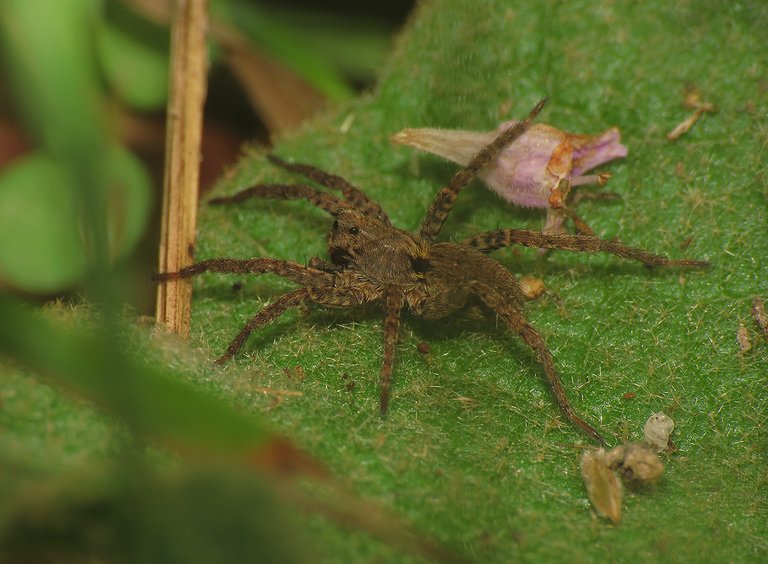
... was photographed on the nearby juicy leaf of the Verbascum undulatum plant ...
... that has formed a relatively large rosette low on the ground.

The spider belongs to the Lycosidae family, that's for sure.
The genus is Pardosa, that's another thing that I'm absolutely sure of, but ...
... but I can't tell you what species exactly this is. Could be the Pardosa agricola, for example. Or Pardosa amentata. Or something else, I don't know.
This very common but quite extravagantly decorated bug ...
... was found and photographed on the dry remains of the Scolymus hispanicus plant.
I saw plenty of these bugs there ...
... and photographed quite a few.
The name of the species is Pyrrhocoris apterus.
The family is Pyrrhocoridae.
These bugs feed mainly on seeds lime trees and mallow plants. But there is a variety of other food they can consume when there's no Tilia or Malva on the menu. Other plants and their seeds. Insect carcasses. Small living insects or weakened bigger living insects and smaller members of their own species, sometimes, especially the soft, freshly molted ones.
On the 25th of October, the dry Scolymus hispanicus probably still had some seeds left on it.
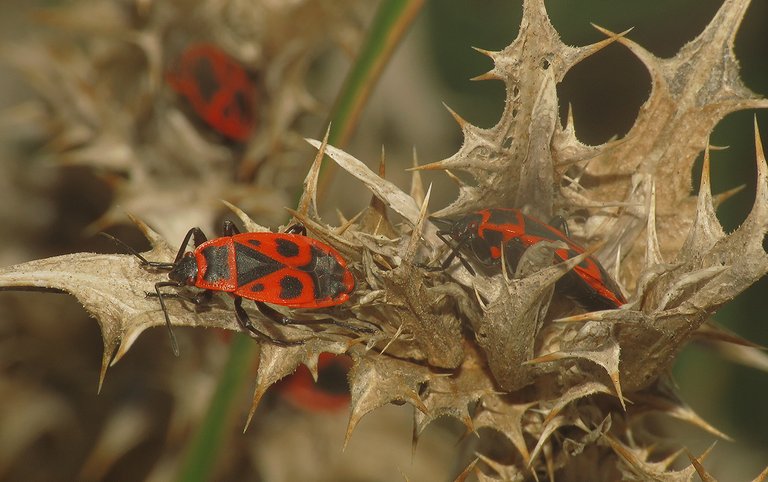
Besides a bit of food, the dead plant also offers a great shelter.
Reaching a Pyrrhocoris apterus surrounded by all these hard, sharp thorns isn't an easy task.

Since the day was warm and I was still wearing summer clothes, photographing the bugs in their thorny citadel was a painful endeavor. After leaving the bugs ...
... I photographed a small chunk of the scenery with the Echium italicum in the foreground, and then ...
... after some more walking ...
... I came across a small fig tree (Ficus carica).
Here you can see another Pezotettix giornae grasshopper. This species did not only appear in quite a few of the previous photographs but also at the beginning of today's post. In the following photograph ...
... you can see the completely dry but impressively tall Onopordum illyricum thistle on which the grasshopper was photographed.
This lovely yellow butterfly, the Colias croceus from the Pieridae family, was resting in the grass near the thistle.
Among the dry stems and foliage on the lower part of the plant ...
... I found another grasshopper.
Anacridium aegyptium is probably the biggest grasshopper that can be seen in this area.
AND THAT'S IT. HOPE YOU ENJOYED THIS MACRO SAFARI. AS ALWAYS HERE ON HIVE, THE PHOTOGRAPHS ARE MY WORK.
The following links will take you to the sites with more information about some of the protagonists of this post. I found some stuff about them there.
https://en.wikipedia.org/wiki/Onopordum_illyricum
https://en.wikipedia.org/wiki/Pezotettix_giornae
https://en.wikipedia.org/wiki/Thistle_tortoise_beetle
https://www.gbif.org/species/6097776
https://en.wikipedia.org/wiki/Echium_italicum
https://en.wikipedia.org/wiki/Aiolopus_strepens
https://en.wikipedia.org/wiki/Eublemma_parva
https://en.wikipedia.org/wiki/Pardosa
https://en.wikipedia.org/wiki/Pyrrhocoris_apterus
https://en.wikipedia.org/wiki/Colias_croceus
https://en.wikipedia.org/wiki/Anacridium_aegyptium

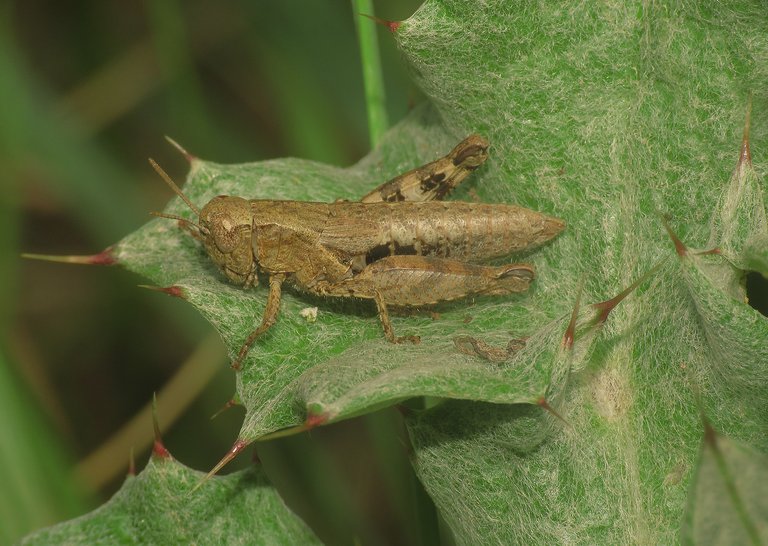

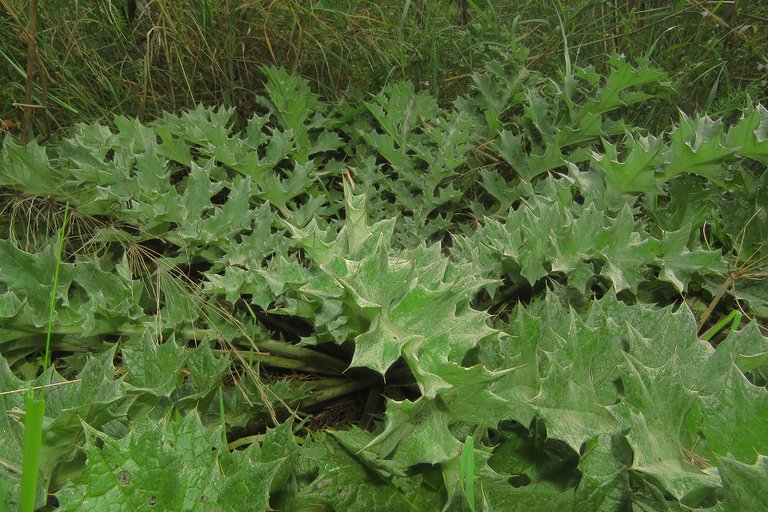
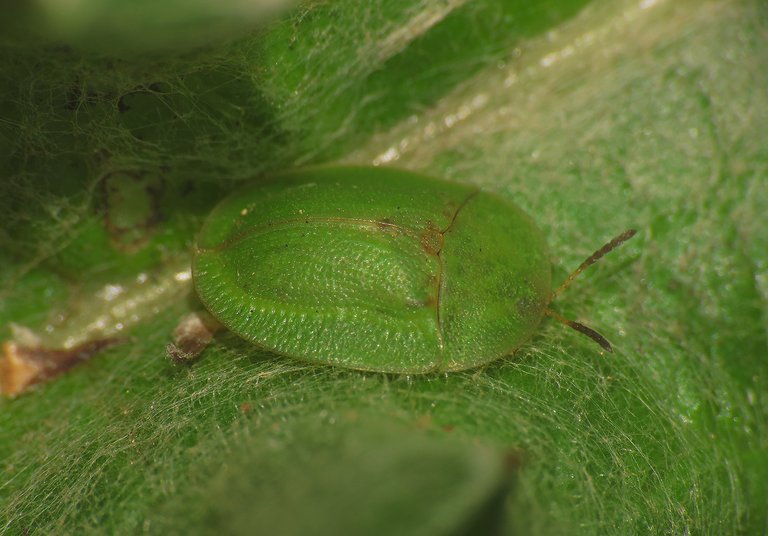
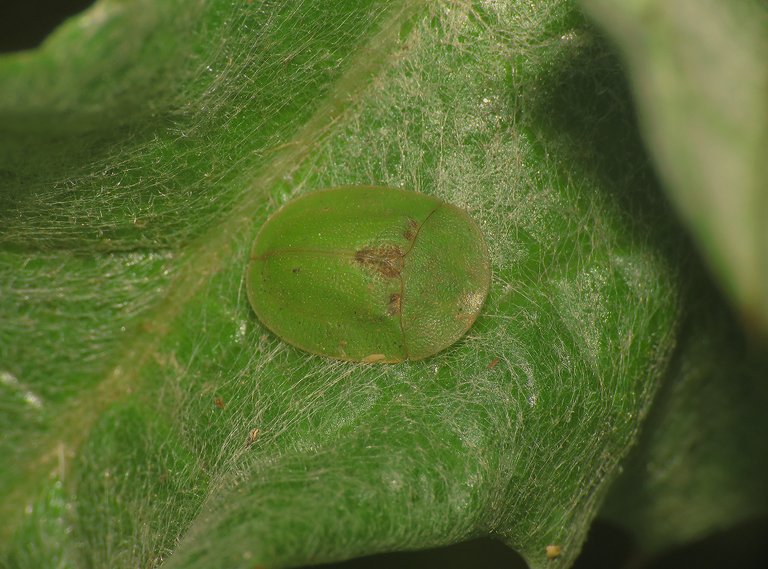
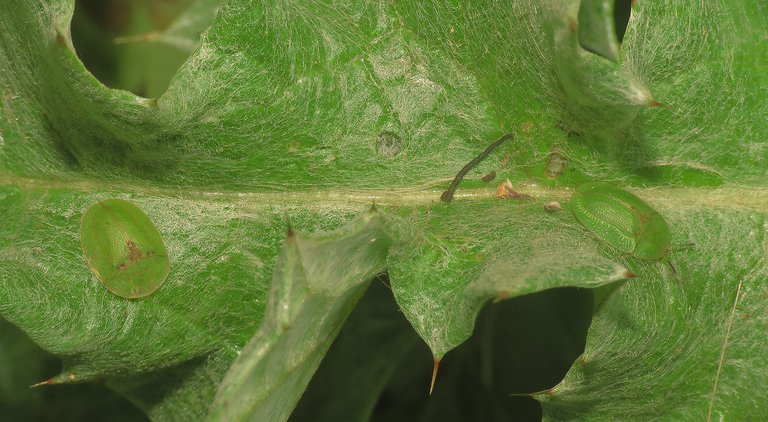
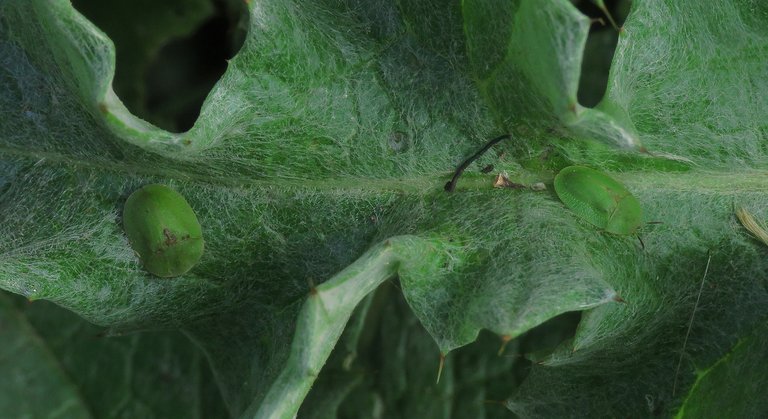

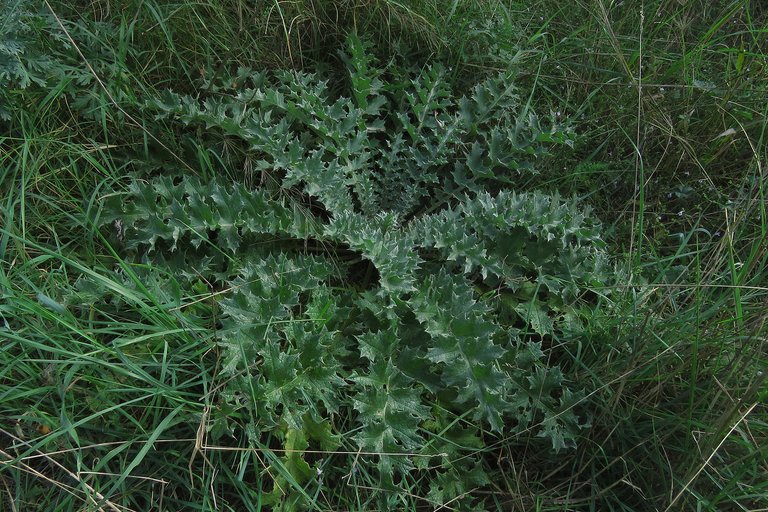

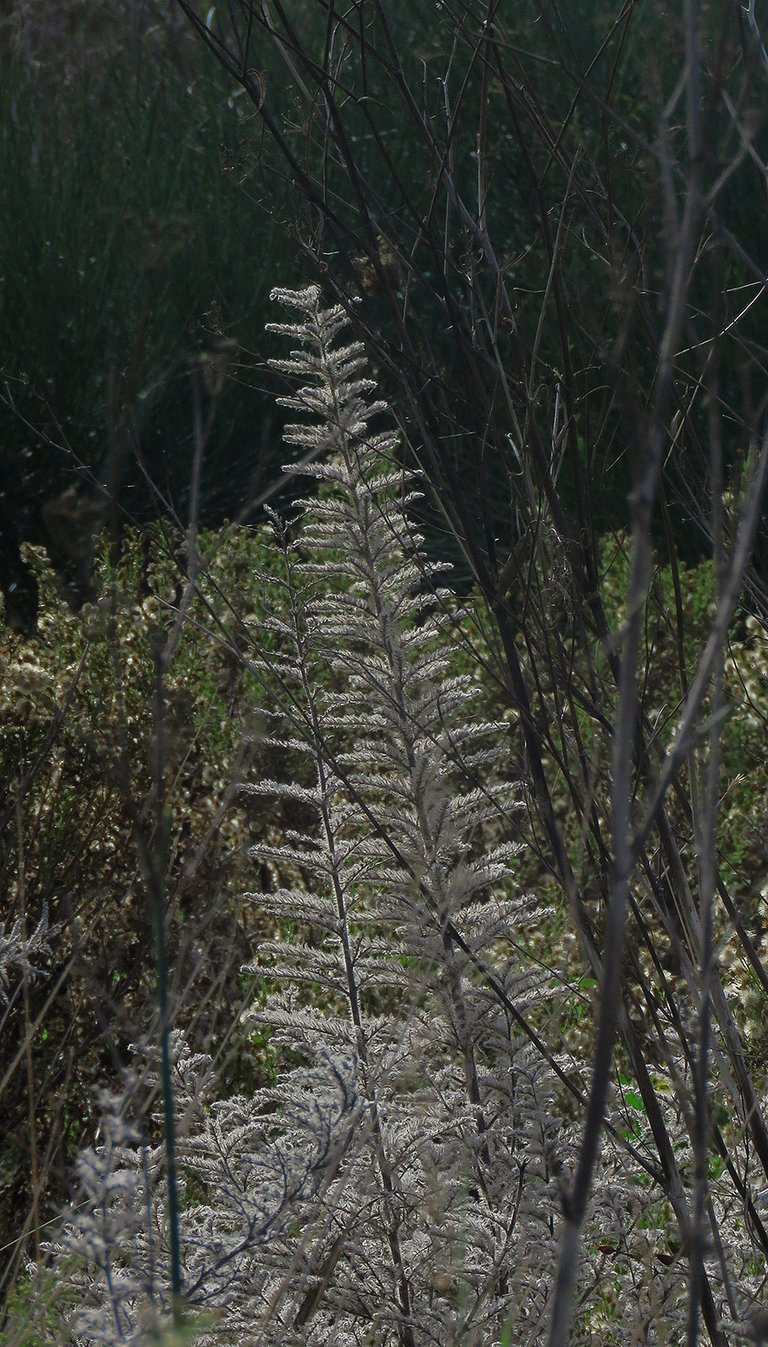
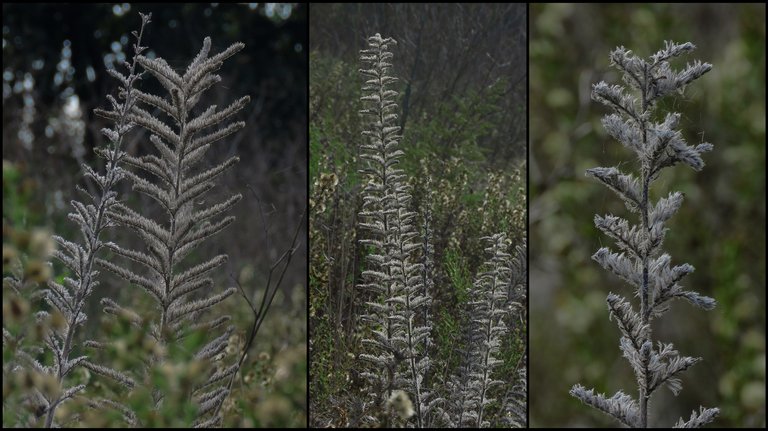
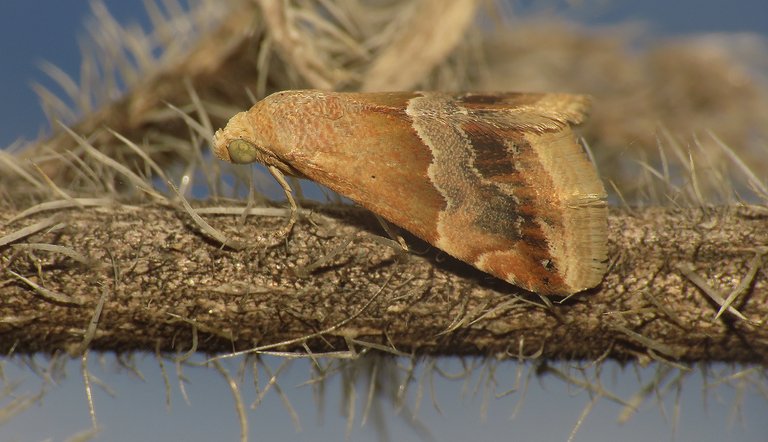
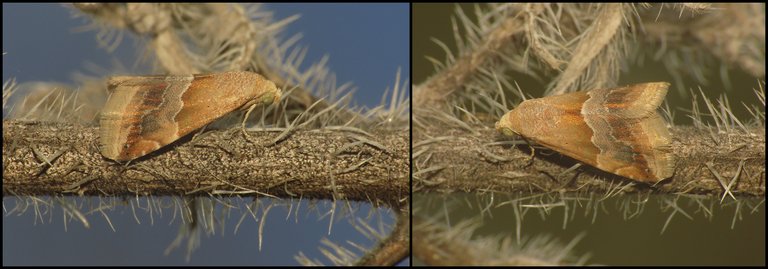

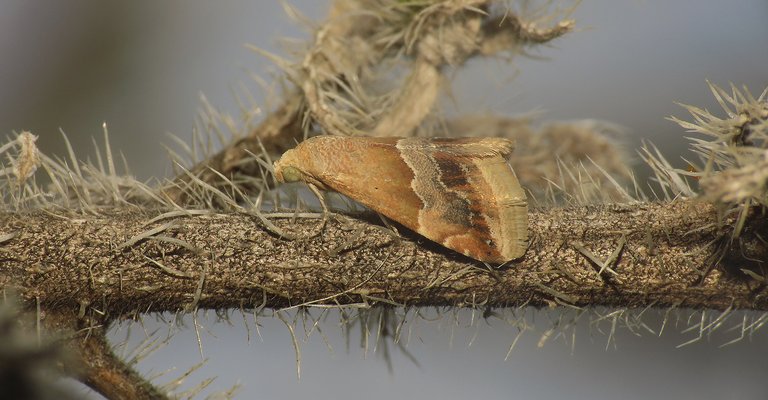
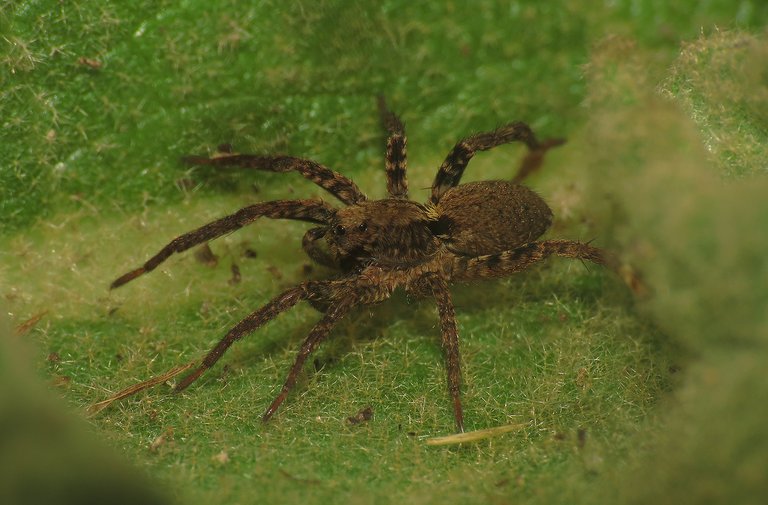
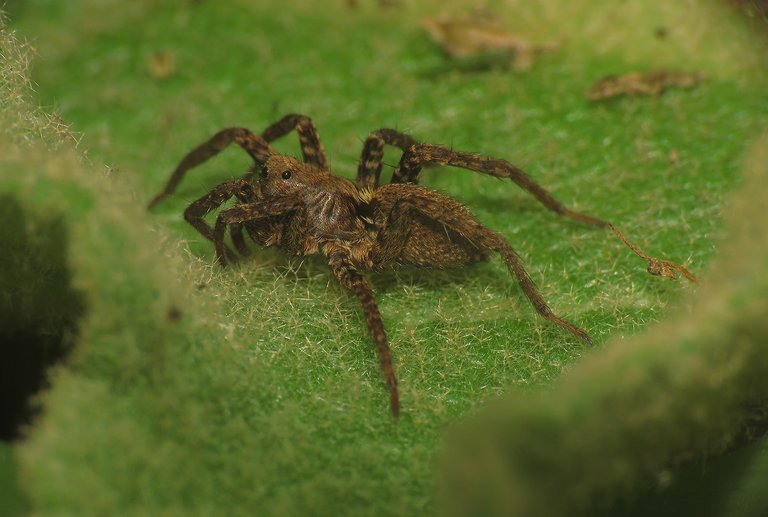

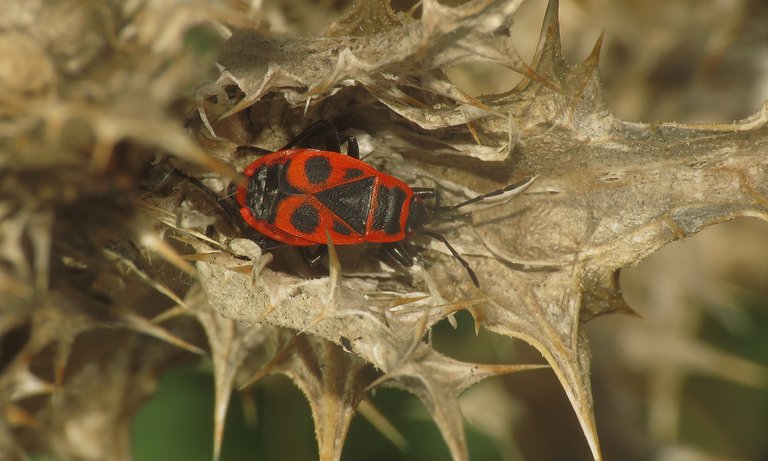




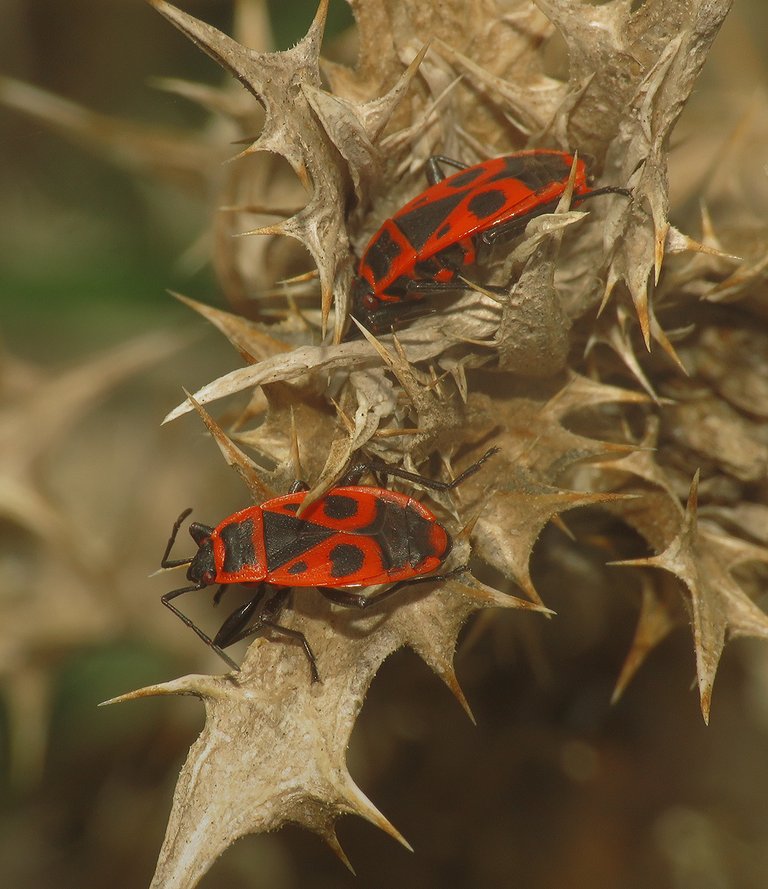

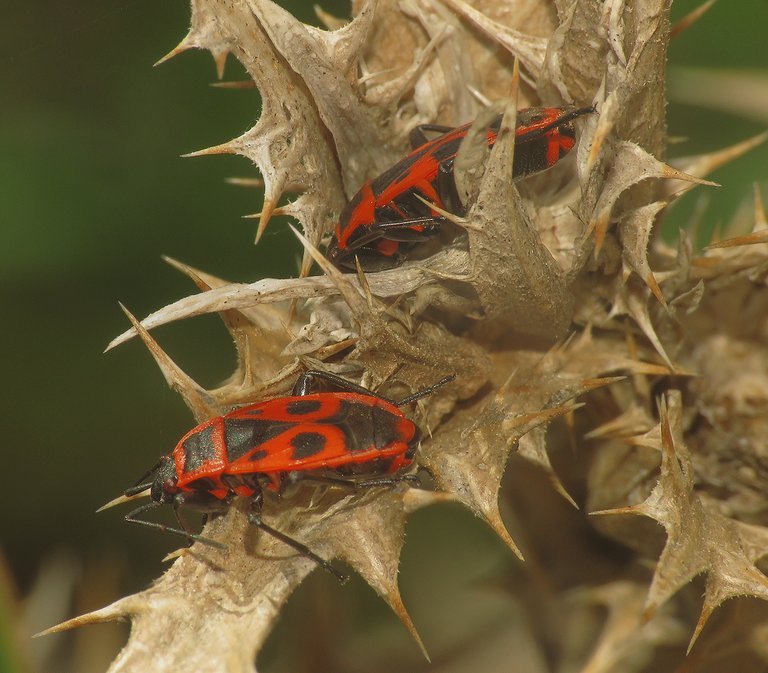
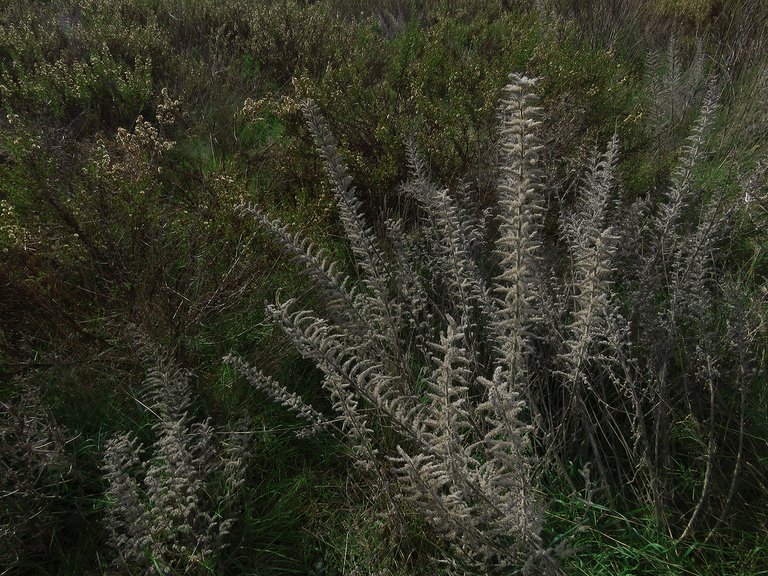
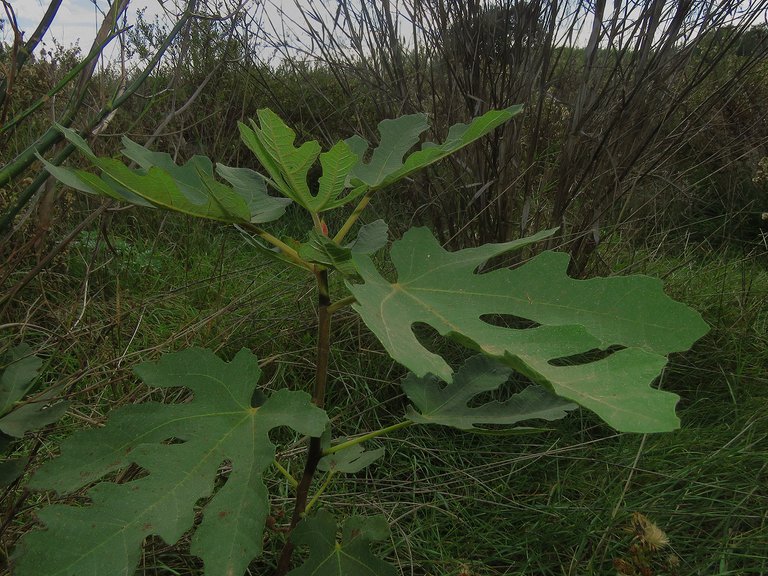
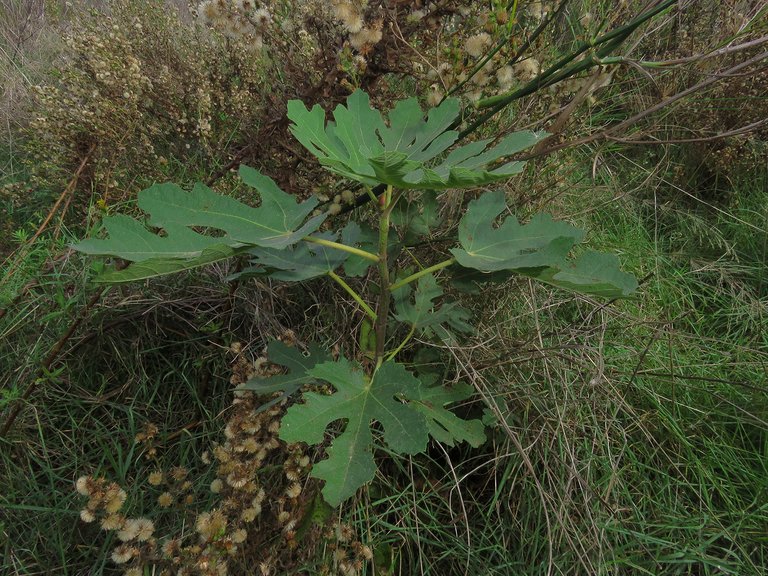
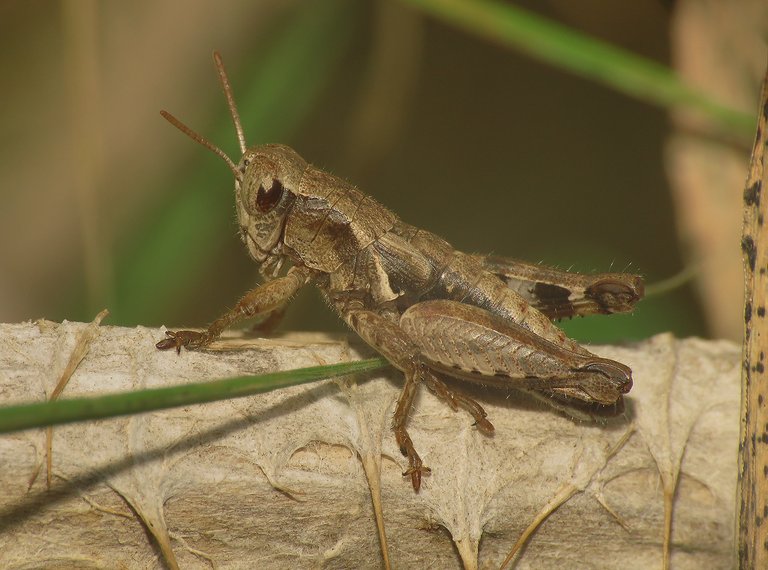

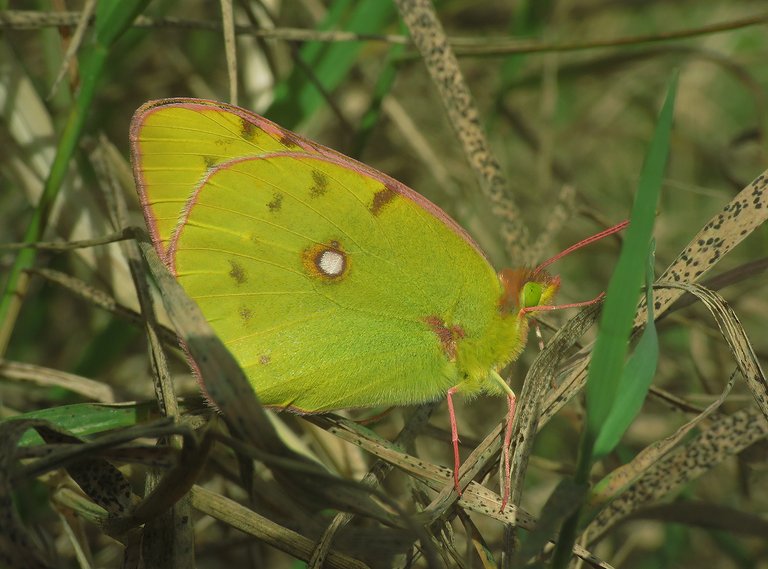
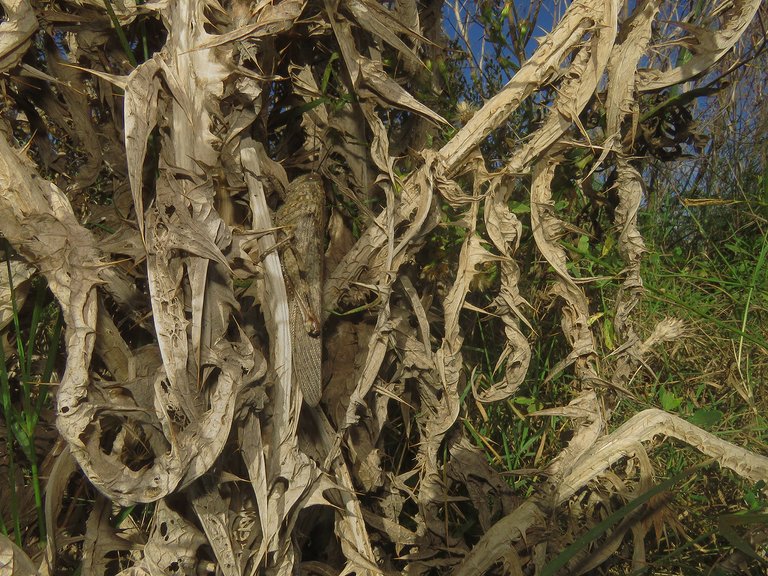
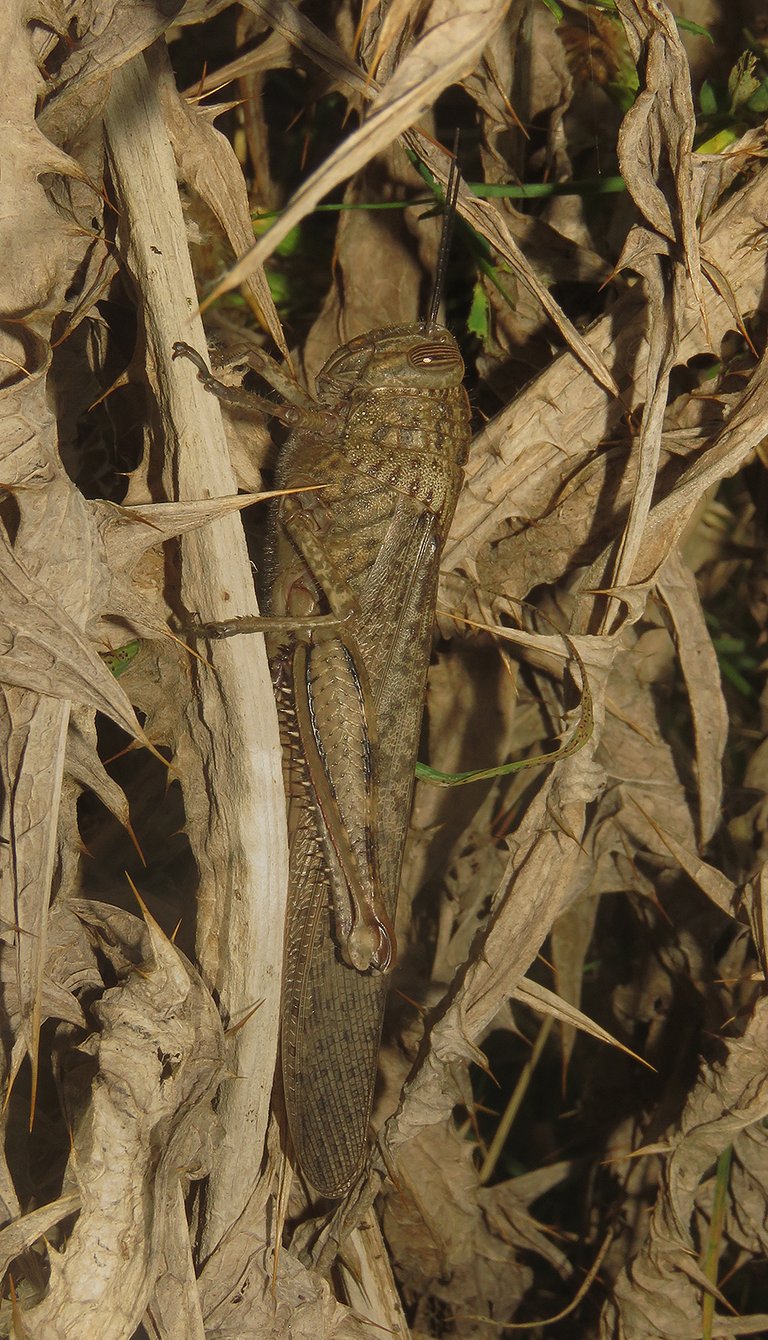


Marlera is a never ending hotspot of natural insects. I love those camouflaged ones, geen one and the yellow one. Beautiful shots borjan as always!
Yes 🙂 those camouflaged beetles are very interesting.

This green colored beetle looks amazing mixed with the color of the leaves. This type of grasshopper is a common insect in our region and can be seen on the leaves of various plants. You have photographed all of them very beautifully.
Marlera will definitely be a place to visit and explore around 😊
🙂
Todas las fotos me encantaron, todo muy hermoso mis 🐝🦋 insectos salieron fino.
Recuerda siempre lo de el proyecto zoológico de insectos.
🐝🪰🐛🦋🙂🦋🧑🍳🪰🐝
The colours of the insects are so beautiful to look out, the beetle and bug especially filled my heart with delight as I read through.
You're welcome.
Very beautiful clicks and I think You like to captured insects and very beautiful species.
I love the eyes on the Anacridium aegyptium grasshopper. Grasshoppers have cool eyes often. The Cassida margaritacea beetle is such a wonderful color, with the iridescence.
Yes, some insects definitively have cool eyes. Sometimes the eyes are iridescent like the exoskeleton of the Cassida margaritacea.
I hadn't noticed that. I'll have to watch for it. Cool fact!
Beautiful picture, those green bugs have a unique color, shiny green, it's awesome
Lots more fascinating Nature photos of "bugs the flora" from you, that are near to your village of Liznjan. This seems to be the most perfect place to visit for something interesting to photograph. !VSC 👌
Stay !ALIVE Borjan & enjoy your day !PIZZA 🙃
@fun.farms has sent VSC to @borjan
This post was rewarded with 0.1 VSC to support your work.
Join our photography communityVisual Shots
Check here to view or trade VSC Tokens
Be part of our Curation Trail
@fun.farms ha enviado VSC a @borjan
Éste post fue recompensado con 0.1 VSC para apoyar tu trabajo.
Únete a nuestra comunidad de fotografía Visual Shots
Consulte aquí para ver o intercambiar VSC Tokens
Se parte de nuestro Trail de Curación
@borjan! You Are Alive so I just staked 0.1 $ALIVE to your account on behalf of @ fun.farms. (1/10)
The tip has been paid for by the We Are Alive Tribe through the earnings on @alive.chat, feel free to swing by our daily chat any time you want, plus you can win Hive Power (2x 50 HP) and Alive Power (2x 500 AP) delegations (4 weeks), and Ecency Points (4x 50 EP), in our chat every day.

$PIZZA slices delivered:
fun.farms tipped borjan
@jlinaresp(6/10) tipped @borjan
you get so many photos of insects while you are there, some of them have beautiful colors or feathers, like moths with beautiful patterns on their feathers, not only insects, some other wild leaves are also very beautiful
Marlera indeed never disappoint. This photos are beautiful, I could not help but kept wowing at each slide. I suspect that the two beetles were just blushing on each other there.
Happy start of the week @borjan. Spectacular photos, and well this weekend I saw some critters like Pyrrhocoris apterus but the photos looked terrible. I hope to have better luck. You already have it.
A virtual hug 🌼🙏
Good luck with insects 🙂 some times one must have a bit of luck becouse they often run or fly around and aren't easy to catch with the camera. If you don't have a macro lens, the bigger insects like grasshoppers and butterflies look better in the photograph. To get a good shot of very small ones one needs some kind of magnifying lens.
An apotheosic diversity and with wonderful photos as usual... I am amazed at the bio-diversity of insects and arachnids there!... It would seem as if you were in our tropics, I even see more than here and very similar species!... You must have some "super power" to attract bugs and make them pose!...ha ha ha :)) If you were an X-Men they would call you something like "Bug-shot" Haaa haaa haa :)).... you should patent that name before Marvel uses it!...
Thanks for sharing @borjan friend, always is a pleasure for me seeing your macro shots!
!discovery 35
!VSC
!PIZZA
!BBH
@jlinaresp has sent VSC to @borjan
This post was rewarded with 0.1 VSC to support your work.
Join our photography communityVisual Shots
Check here to view or trade VSC Tokens
Be part of our Curation Trail
@jlinaresp ha enviado VSC a @borjan
Éste post fue recompensado con 0.1 VSC para apoyar tu trabajo.
Únete a nuestra comunidad de fotografía Visual Shots
Consulte aquí para ver o intercambiar VSC Tokens
Se parte de nuestro Trail de Curación
@borjan! Your Content Is Awesome so I just sent 1 $BBH (Bitcoin Backed Hive) to your account on behalf of @jlinaresp. (1/5)
Hahaha 😃 yes, the bug spirit guides me in my macro endeavor.

My biggest dream is to visit at least one tropical area and photograph some of the amazingly colorful species that live there.
My second dream is to live for the rest of my life in a tropical area with lush forests where I would be able to find all this macro stuff throughout the year.
This post was shared and voted inside the discord by the curators team of discovery-it
Join our Community and follow our Curation Trail
Discovery-it is also a Witness, vote for us here
Delegate to us for passive income. Check our 80% fee-back Program
https://reddit.com/r/blogs/comments/17zqh0a/macro_october_in_marlera_episode_fourteen_on/
The rewards earned on this comment will go directly to the people( @jlinaresp ) sharing the post on Reddit as long as they are registered with @poshtoken. Sign up at https://hiveposh.com.
I’m very sure that there will be uncountable insects in Marlera
The picture are looking good just like the ones you always upload
Keep it up!
https://twitter.com/lee19389/status/1726664618863636881
#hive #posh
these are very difficult to find due to the almost perfect way of camouflage
A wonderfully long and interesting post ;))
https://twitter.com/JunaidFazal1111/status/1726807989565153697
❤
The spectacular photos you show today my brother, I was so surprised to see some of the attacking images above. You were very successful in aiming at it. I'm speechless other than amazing picture
Some of the insects are camouflage. Shots are excellent.
https://twitter.com/jewellery_all/status/1726882333914206227
It looks like a jewel in a ring
In winter, when this weather comes, the sun is out, it is very good. One goes out of the house, it is not cold, and one sits under the sun for a while, then one gets a lot of peace.
That's a collection of really brilliant photos!
Thank you. 🙂 Glad you like the post ... or, said in a more colorful way

Really you are an amazing photographer and content writer I have tried little bit inspired from your photography.
https://ecency.com/hive-101587/@michaellyn129/a-spider-s-dance-in